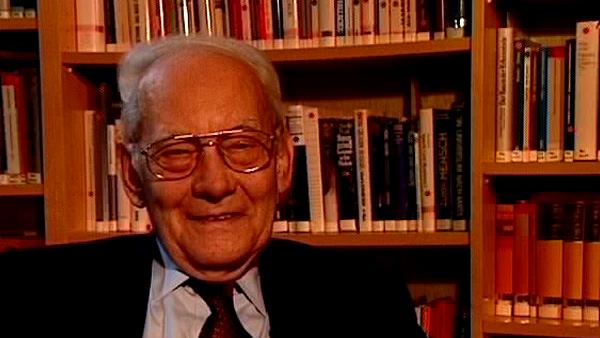NEXT STORY

The error threshold and the origin of the hypercycle work
RELATED STORIES

NEXT STORY

The error threshold and the origin of the hypercycle work
RELATED STORIES



The Nobel Prize came in '67...
[Q] Yes.
And I remember there was before that there was a Nobel symposium in Stockholm, where I went to... and the most examples I talked about there were biological reactions, where allosteric reactions, where DNA... we measured also how quickly can the information be read off from a DNA molecule. And this is again a very rapid process. The AU pair has a lifetime of 10-7 seconds...
[Q] 'A' is...
'A' is the adenine-uracil, yes. You know the four letters of the alphabet of nucleic acid is AUG and C, or ATG and C, that is DNA. And the GC pair has three hydrogen bonds so it's a little bit more stable than the AU or AT pair ‒ but the one has a lifetime of 10-7 seconds so a tenth of a millionth of a second, and the other has 10-6 seconds, that's a millionth of a second.
[Q] Yes, but these were the experiments, these were the outcome, the interpretation, of the experiments. But what I'm now aiming is the profound, basic theory and thinking of...
Well, but I remember well that I said, 'Yes, they say Darwin. Could it be possible that Darwin's principle works already at the level of molecules?' And so I sit down to find out what does it mean. What does selection mean? Who selects? Well, it came out it has to be a self-organising property. There's nobody to select. There's nobody who knows what is fittest. So I found out what you need is reproduction. Well, nucleic acids do reproduce. They even do it without enzymes. Not as precisely as it is required for the life processes, but... so I worked out a theory... a kinetic theory of reproduction of nucleic acids. And I found that the outcome was Darwinian behaviour. And I found out that all organisms to which Darwin's principle applies have the same properties. Via the reproduction of nucleic acids, DNA, RNA, the whole cell can reproduce or the whole organism can reproduce, it's based on it.
Now, working out such a theory is a little bit different from what population geneticists have done so far, because for them the reproduction of an individual, well, they don't know what mutations would appear during the process and so on. Here, working with single molecules, we can pinpoint everything. We could say, 'Yes, if there is a mutation, it means that the wrong base comes in and what processes are there'. So we took care of it. The result was not simply a new Darwinian theory, it was a much more precise theory. And we found an error threshold, and that the best reproduction is near the error threshold because if it is still below the error threshold, which is somehow a threshold at which the information evaporates, it's a two-faced transition, and below that you can keep the information, you can transfer it from generation to generation. So you have to be below the error threshold but not too far below because if you are too far below you don't make mutations any more. Mutations are errors in the base-pairing mechanism. So you had fastest evolution, fastest changes, without losing information right at the error threshold, and we later found out that all viruses work this way.
Nobel Prize winning German biophysical chemist, Manfred Eigen (1927-2019), was best known for his work on fast chemical reactions and his development of ways to accurately measure these reactions down to the nearest billionth of a second. He published over 100 papers with topics ranging from hydrogen bridges of nucleic acids to the storage of information in the central nervous system.
Title: Proposing that Darwin's principle works at the molecular level
Listeners: Ruthild Winkler-Oswatitch
Ruthild Winkler-Oswatitsch is the eldest daughter of the Austrian physicist Klaus Osatitsch, an internationally renowned expert in gas dynamics, and his wife Hedwig Oswatitsch-Klabinus. She was born in the German university town of Göttingen where her father worked at the Kaiser Wilhelm Institute of Aerodynamics under Ludwig Prandtl. After World War II she was educated in Stockholm, Sweden, where her father was then a research scientist and lecturer at the Royal Institute of Technology.
In 1961 Ruthild Winkler-Oswatitsch enrolled in Chemistry at the Technical University of Vienna where she received her PhD in 1969 with a dissertation on "Fast complex reactions of alkali ions with biological membrane carriers". The experimental work for her thesis was carried out at the Max Planck Institute for Physical Chemistry in Göttingen under Manfred Eigen.
From 1971 to the present Ruthild Winkler-Oswatitsch has been working as a research scientist at the Max Planck Institute in Göttingen in the Department of Chemical Kinetics which is headed by Manfred Eigen. Her interest was first focused on an application of relaxation techniques to the study of fast biological reactions. Thereafter, she engaged in theoretical studies on molecular evolution and developed game models for representing the underlying chemical proceses. Together with Manfred Eigen she wrote the widely noted book, "Laws of the Game" (Alfred A. Knopf Inc. 1981 and Princeton University Press, 1993). Her more recent studies were concerned with comparative sequence analysis of nucleic acids in order to find out the age of the genetic code and the time course of the early evolution of life. For the last decade she has been successfully establishing industrial applications in the field of evolutionary biotechnology.
Tags: Nobel Prize in Chemistry, allosteric reactions, nucleic acids, reproduction, Darwinian behaviour, DNA, RNA, base-pair, mutations, error threshold, Charles Robert Darwin
Duration: 4 minutes, 40 seconds
Date story recorded: July 1997
Date story went live: 24 January 2008